Is it time to share the leadership in obstetric emergencies?
 Blog written by Sarah Janssens, Director Clinical Simulation and Sharon Clipperton, Simulation Manager
Blog written by Sarah Janssens, Director Clinical Simulation and Sharon Clipperton, Simulation Manager
As healthcare providers, we are faced with times when we hit the emergency bell and pray for help to arrive soon. No matter where or what the emergency is, when help arrives leadership is vital for the team to work effectively together.
Leadership in emergencies is complex, the role requiring a multitude of tasks that must be performed concurrently. Leaders must assess the team members’ abilities and allocate them to appropriate team roles. While doing this they must comprehensively assess and direct management of the clinical event, anticipate complications that may occur and make plans to manage them. This is inclusive of ensuring appropriate human and material resources are available now and in the future, communicate with the team and others outside the room regarding the situation and keep the patient and family informed. Leaders must also monitor their team members performance, support them when required and manage any conflict that may arise within the team.
When you write it all down like this, it’s no wonder that team leadership during emergency events has often been found lacking and leaders commonly report feeling overwhelmed! Poor leadership is a critical problem; it leads to poorer team performance and puts patients’ lives at risk. Compounding this is the paradox that when situations are most critical, the quality of leadership tends to deteriorate. So how are we addressing this problem?
Leadership research has spent many years looking at how best to lead teams, mainly focusing on the 'who' and 'how' of leadership. There has been some research looking at healthcare teams which come together under high-stakes, time pressured circumstances – these are known as 'action teams'. Action teams in healthcare might be emergency response teams, resuscitation or trauma teams and typically consist of highly specialized clinicians from different professions and disciplines working together, sometimes for the first time.
An early example of leadership research1 filmed real cardiac arrest teams, and found teams performed better when their leader was hands off and created structure within the team. Findings such as these have led to a 'singular leadership' paradigm, where the attributes and styles of leaders are studied to define the ideal team leader. Following on from such work, leadership assessment tools and taxonomies published over the last few years have started to define the how and what of leading action teams in various clinical contexts.2 While providing a framework for assessment and feedback for individual team leaders, such tools are useful in the setting in which they have been developed and validated, but may not be generalizable to different contexts. The other limitation of such tools is that by focusing on individual performance, they fail to address the fact that leadership is often transferred from one clinician to another, or shared across team members during an emergency.
Although not prevalent within the healthcare literature, the concept of shared leadership is well developed in the organisational behaviour literature. Research consistently demonstrates that leadership sharing is associated with improved team performance.3 4 And no wonder, as the task of leadership is commonly too onerous for a single person to perform effectively. We found that leadership sharing is reported in healthcare action teams, but the effects on team performance are not well established.5
Literature from other domains suggests sharing leadership is probably best done in a planned way, with clearly defined leadership tasks shared between a small number of team leaders. In doing this duplication and confusion is avoided, but these leaders must trust each other, communicate effectively and have a common vision of team goals. Sharing leadership doesn’t mean that there is no single person with ultimate responsibility, but that some leadership tasks can be performed by other team members. Trauma teams commonly share leadership between and nurse and medical leader in this way, typically with the doctor leading clinical decisions, and nurses leading resource management and communications. While this works well in this setting, trauma teams have an advantage of mostly being notified prior to their patient’s arrival so they can confirm roles, set expectations and discuss goals. Unfortunately, this rarely happens in other emergency teams, and in particular in birth suite, where emergencies occur unannounced and the team forms around the emergency leaving no time for team briefing. That’s why we’re performing a simulation study to understand if sharing leadership in a planned way in maternity emergencies is effective. We hope to understand if a model similar to that used in trauma teams can be applied successfully in obstetric emergencies. Until we know more, we continue to focus on providing high quality teamwork and leadership training for doctors and midwives working in maternity.
To find out more about Mater Education’s maternity and infant care courses, visit our website.
About the author
Dr Sarah Janssens is the Clinical Simulation Director at Mater Education and a Staff Specialist in Obstetrics and Gynaecology. Sharon Clipperton is the Simulation Manager with Mater Education and an experienced Midwife.
Dr Sarah Janssens is currently undertaking her PhD in shared leadership in maternity emergencies. You can find more of Sarah’s work here.
1. Cooper S, Wakelam A. Leadership of resuscitation teams: ‘Lighthouse Leadership’. Resuscitation 1999;42(1):27-45.
2. Rosenman E IJ, Shandro J, Haper A Fernandez R. A systematic Review of Tools Used to Assess Team Leadership in Healthcare Care Action Teams. Acad Med 2015;90(10):1408-22.
3. Nicolaides VC, LaPort KA, Chen TR, et al. The shared leadership of teams: A meta-analysis of proximal, distal, and moderating relationships. The Leadership Quarterly 2014;25(5):923-42.
4. Wang D, Waldman DA, Zhang Z. A meta-analysis of shared leadership and team effectiveness. Journal of Applied Psychology 2014;99(2):181-98.
5. Janssens S, Simon R, Beckmann M, et al. Shared Leadership in Healthcare Action Teams: A Systematic Review. J Patient Saf 2018.



